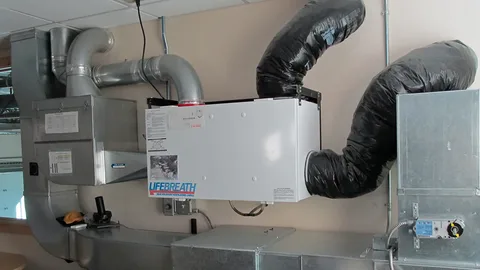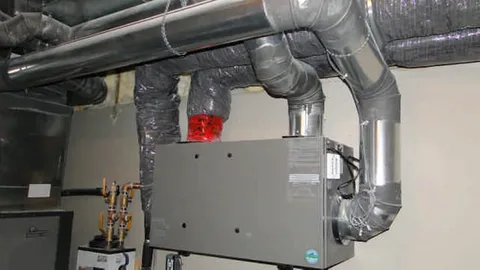Are you looking for ways to improve the ventilation in your home while also increasing energy efficiency? If so, passive ventilation with heat recovery could be just the solution you’re looking for. This blog post, will dive deeply into this exciting and relatively new technology – discussing how it works, the different types of systems available, and how to calculate the best size for your needs. So, let’s get started on revving up your home’s ventilation game!
The Importance Of Proper Home Ventilation
Proper home ventilation is essential for maintaining a healthy and comfortable living environment. It not only helps to remove excess moisture, odors, and pollutants from your home but also ensures the proper circulation of fresh air.
One of the main benefits of proper home ventilation is the prevention of mold growth. Mold thrives in damp and poorly ventilated areas, and it can quickly spread throughout your home, causing structural damage and various health issues. By allowing fresh air to circulate, you can minimize the risk of mold growth and protect your home and your family.
Off-Gassing From Household Products
Furthermore, proper ventilation helps to improve indoor air quality. Indoor air can be up to five times more polluted than outdoor air due to dust, pet dander, cooking fumes, and off-gassing from household products. With effective ventilation, these pollutants are continuously removed, ensuring you and your family breathe clean and fresh air.
In addition to health benefits, proper ventilation also helps to regulate temperature and moisture levels in your home. During the hot summer months, ventilation allows for the expulsion of hot air and the entry of cooler air, creating a comfortable living environment.
How Passive Ventilation System Works?
Passive ventilation is a fascinating and innovative technology that can significantly improve the ventilation in your home while also increasing energy efficiency. But how exactly does it work? Let’s dive in and find out.
Passive ventilation systems work by using the natural airflow in your home to bring in fresh air while simultaneously extracting stale air. These systems typically consist of two main components: the supply air ducts and the exhaust air ducts. The supply air ducts bring fresh air from outside, while the exhaust air ducts remove stale air inside your home.
Domestic Heat Recovery Ventilation Remove Pollutants
Regarding heat recovery ventilation, there are several key factors to consider. This technology, also known as HRV, provides a highly efficient way to improve the ventilation in your home while also recovering heat energy.
In a domestic heat recovery ventilation system, fresh air is brought in from outside and stale air is extracted inside your home. The two airflows pass through a heat exchanger, where the heat from the outgoing air is transferred to the incoming air. This process preheats the fresh air, reducing the need for additional heating.
One of the main advantages of heat recovery ventilation is its ability to maintain a consistent indoor temperature. By recovering heat energy, these systems help to prevent drafts and ensure a comfortable living environment.
Types Of Heat Energy Recovery System
When it comes to heat energy recovery system, there are a few different options available. Each type of system has unique features and benefits, allowing you to choose the one that best suits your home and ventilation needs.
One common type of energy recovery system is the air-to-air heat exchanger. Using a heat exchanger, this system transfers heat from the outgoing air to the incoming air. The heat from the stale air is extracted and transferred to the fresh air, preheating it before it enters your home. This type of system is known for its energy efficiency and ability to maintain a consistent indoor temperature.
Beneficial In Climates With Extreme Temperature
Another option is the earth-to-air heat exchanger. This system utilizes the ground’s natural temperature to preheat or cool the incoming fresh air. It works by burying a series of pipes underground, which the fresh air passes through before entering your home.
Finally, there are also water-to-air heat exchangers, which transfer heat energy from water sources to the incoming fresh air. These systems are often used with geothermal heat pumps or solar water heaters, utilizing the energy from these sources to preheat or cool the fresh air.
The type of energy recovery system you choose will depend on various factors, including your climate, budget, and specific ventilation needs. It’s essential to consult with a professional to determine the best option for your home.
 The Role Of A Heat Recovery Fan In Your Ventilation System
The Role Of A Heat Recovery Fan In Your Ventilation System
When it comes to passive ventilation, a crucial component in the system is the heat recovery fan. This fan plays a vital role in the ventilation system, ensuring the proper circulation of fresh air while also maximizing energy efficiency.
The heat recovery extracts stale air from your home and pushes it through the heat recovery unit. As they discussed earlier, this unit uses a heat exchanger to transfer the heat from the outgoing stale air to the incoming fresh air. The heat recovery ensures that this transfer occurs efficiently, effectively recovering as much heat as possible.
Sizing Your Heat Recovery Ventilator: What You Need To Know
Choosing the right size for your heat recovery ventilator ensures optimal performance and efficiency. Here’s what you need to know to make the right decision.
Firstly, it’s important to determine the airflow requirements of your home. This can be done by calculating the volume of your living space, considering factors such as the number of rooms, ceiling height, and occupancy.
Next, consider the specific needs of your home. Are any areas requiring higher ventilation rates, such as bathrooms or kitchens? Take these factors into account when choosing the size of your ventilator. Additionally, consider the climate in which you live.
Assess Your Home
Lastly, consult with a professional. An HVAC specialist can assess your home and recommend the ideal size for your heat recovery ventilator based on your specific needs and budget. They will consider factors such as the layout of your home, insulation levels, and the condition of your existing ductwork.
Remember, choosing the right size for your heat recovery ventilator is essential for optimal performance and energy efficiency. So take the time to carefully consider these factors and consult with an expert to ensure you make the best choice for your home.
The Benefits Of Heat Recovery Ventilator Sizing
Properly heat recovery ventilator sizing is crucial for maximizing its benefits and optimizing energy efficiency in your home. By choosing the right size, you can ensure that your HRV operates at its highest capacity, providing you with a constant supply of fresh air while effectively recovering heat energy.
One of the main benefits of correctly sizing your HRV is improved indoor air quality. A properly sized system ensures that your home receives the necessary fresh air exchange, effectively removing pollutants, odors, and excess moisture.
Reducing The Need For Additional Heating
Another benefit is increased energy efficiency. By selecting a HRV that matches the airflow requirements of your home, you can prevent over-ventilation, which can lead to unnecessary heat loss or gain. This means your HRV will work efficiently, recovering as much heat as possible from the outgoing stale air and reducing the need for additional heating or cooling.
Also, properly sized hrvs help prevent issues such as condensation and mold growth. You can minimize humidity levels and maintain a comfortable indoor environment by ensuring sufficient ventilation rates.
Overall, investing the time and effort into sizing your HRV correctly can lead to numerous benefits, including improved indoor air quality, enhanced energy efficiency, and a healthier, more comfortable living space.
Maximizing Efficiency With A Heat Recovery Ventilator
Maximizing efficiency is key when it comes to improving your home’s ventilation. With a heat recovery ventilator (HRV), you can take your ventilation game to the next level and achieve optimal energy efficiency. But how can you ensure that your HRV is operating at its highest efficiency? Here are some tips for maximizing efficiency with a heat recovery ventilator.
Firstly, regular maintenance is essential. Keeping your HRV clean and free from dust and debris will ensure it operates at peak performance. Regularly check and clean the filters, as clogged filters can reduce airflow and hinder efficiency.
FAQs
Q: How Does Passive Ventilation With Heat Recovery Differ From Traditional Ventilation Systems?
A: Passive ventilation with heat recovery uses the natural airflow in your home to bring in fresh air and extract stale air, while also recovering heat energy. This differs from traditional ventilation systems that use mechanical fans to circulate air.
Q: How Much Does A Passive Ventilation System Cost?
A: The cost of a passive ventilation system can vary depending on the size of your home and the specific system you choose. On average, you can expect to pay anywhere from $2,500 to $7,500 for a complete system, including installation. While the upfront cost may seem high, the energy savings over time can make it a worthwhile investment.
Q: Can I Install A Passive Ventilation System Myself?
A: It is recommended to hire a professional HVAC contractor to install a passive ventilation system. This ensures the system is properly sized, installed, and balanced for optimal performance. DIY installation can lead to inefficiencies and may void any warranties on the system.
Q: Will A Passive Ventilation System Reduce Noise From Outside?
A: While passive ventilation systems can help reduce noise from outside, they are not specifically designed for noise reduction. However, insulated ductwork and careful system design can help minimize noise transfer from outside sources.
Q: How Often Should I Clean And Maintain My Passive Ventilation System?
A: It is recommended to clean and maintain your passive ventilation system regularly. This includes cleaning or replacing filters, checking and cleaning the heat exchanger, and ensuring all components function properly.
Conclusion
In this blog post, they have explored the world of passive ventilation and how it can revolutionize how you ventilate your home. They have discussed the importance of proper home ventilation, the benefits of passive ventilation, and the different types of systems available. They have also delved into the role of a heat recovery and the importance of properly sizing your heat recovery ventilator. Additionally, they have shared some tips for maximizing efficiency with a heat recovery ventilator and answered frequently asked questions.

